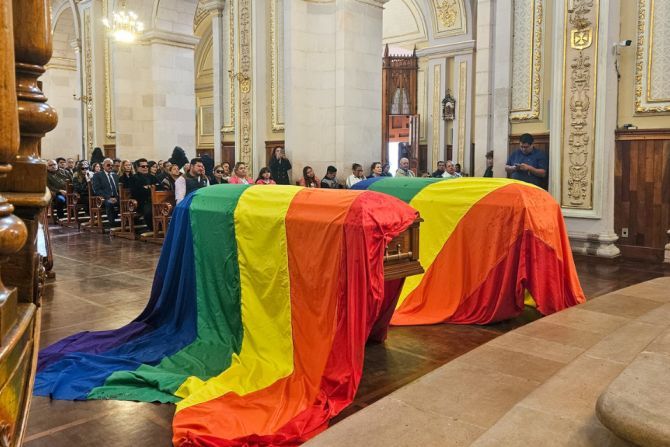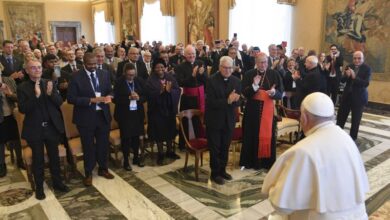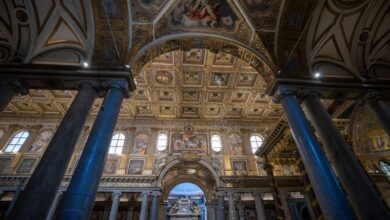Archbishop justifies LGBT flags on coffins in Mexican cathedral

 Coffins with the LGBT flag in Aguascalientes cathedral in Mexico. / Credit: María Miranda Franco/Metropolitano Aguascalientes
Coffins with the LGBT flag in Aguascalientes cathedral in Mexico. / Credit: María Miranda Franco/Metropolitano Aguascalientes ACI Prensa Staff, Nov 17, 2023 / 19:00 pm (CNA).
The vice president of the Mexican Bishops’ Conference, Archbishop Gustavo Rodríguez Vega, justified the draping of LGBT flags on the coffins of a gay activist and his partner during their funeral held in the Aguascalientes cathedral, despite the scandal that this has caused among the faithful.
The caskets were covered with the flags during the funeral Mass of the “nonbinary” judge and activist Ociel Baena and his romantic partner, which was held on the morning of Nov. 14.
Both bodies were found with indications of violence inside Baena’s house on Nov. 13. The attorney general’s office of Aguascalientes state reported in a statement posted on Facebook that day that “everything indicates that it could be a personal matter” since “a sharp instrument” was found in the hands of one of the deceased.
Several comments on the post questioned the quick conclusions of the investigators and claimed it was a hate crime, alluding to Ulises Nava, a gay rights activist who was gunned down in July as he was leaving an event organized by Baena.
As can be seen in the photos and videos circulating on social media, at the funeral Mass of Baena and his partner, people from his circle placed the LGBT flags on the coffins.
In a press conference held Nov. 16, Rodríguez, who is also the archbishop of Yucatán, pointed out that Baena and his partner are “children of God and our brothers” and so “we could not, in any way, not receive them in the church. Especially when the family wanted them to be taken there [the Aguascalientes cathedral].”
When asked by ACI Prensa, CNA’s Spanish-language news partner, about the placement of the flags, the archbishop commented that “if they place those flags, which meant so much to them, well, we respect that.”
“There is no problem,” continued the vice president of the bishops’ conference, because “there was no intention to offend anyone.”
“They are also welcome to all the services that the Church can offer,” he concluded.
Who was Ociel Baena?
Born in Saltillo in 1984, Baena graduated in law from the Autonomous University of Coahuila and held a doctorate in law from the Autonomous University of Durango. He originally held the position of secretary general of Accords of the Electoral Court of the State of Aguascalientes, but in October 2022, after the departure of Claudia Eloísa Díaz de León González, he assumed the interim position of judge, which he was to hold until the federal senate would appoint his replacement.
Baena, who identified as a “nonbinary” person, asked to be called “magistrade” as part of his LGBT activism. “Magistrade” is a made-up word in Spanish because it is correctly spelled magistrado (male judge) or magistrada (female judge). In May he was the first to receive a “nonbinary” passport, a category created by the government of President Andrés Manuel López Obrador.
Involved in various controversies, on Oct. 31 he upset Catholics by posting a photograph of himself on social media dressed as the Virgin Mary.
Can LGBT flags be displayed at a funeral Mass?
In a Nov. 15 interview with ACI Prensa, Father Francisco Torres Ruiz, an expert in liturgy of the Diocese of Plasencia in Spain, explained that “it’s not permissible to put any type of symbology at funeral Masses, especially when that symbology represents ideologies contrary to Christian anthropology, that is, when they are against the faith.”
“What is admitted is, when a head of state or a soldier is buried, who have their own protocol, putting the national flag, the flag of the country, on the coffin. But never a flag that detracts from the sacred place that is a church.”
“Nor can any other symbol or photo of the deceased be placed during the funeral celebration,” he explained, “because in the church the only images, the only photos or icons, are always those of the saints or the diocesan bishop or of the pope, but never that of the deceased who is being buried.”
What could the priest have done?
For Torres, if the placing of the flags had occurred before the start of the Mass, the priest would have had the opportunity to “indicate to the family or the funeral planners that that symbology is strictly prohibited.”
“If ‘treasonously’ they place it during the ceremony, it’s a very forced situation for the priest, because he’s not going to stop a celebration to remove that flag,” he said.
“Although it may perfectly be the case that the priest, during the homily or at any time, makes some observation or orders the family or the organization to remove that symbol. But it is certainly a very forced situation for the priest who has to preside over the celebration,” he noted.
Why is the funeral Mass important for Catholics?
Torres explained that the funeral Mass “is not just another ceremony, but rather it is the last expression of the spiritual motherhood of Holy Mother Church for her children who have passed from this world to the next.”
“Christian funerals are always an action to aid the person who is buried, that is, to implore the eternal rest of the soul of the person” who “may have some type of unforgiven sin or unrepaired guilt.”
“Then we think that he is in purgatory and what the Church does by offering this Mass is to ask for the purification of that person, for the forgiveness of his sins,” so that he can “enter the kingdom of heaven.”
This story was first published by ACI Prensa, CNA’s Spanish-language news partner. It has been translated and adapted by CNA





